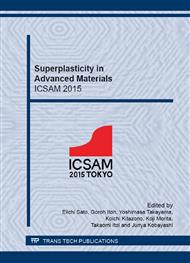p.249
p.256
p.261
p.267
p.272
p.278
p.287
p.294
p.302
Tensile Properties of Recrystallized and Unrecrystallized Tungsten at Elevated Temperatures
Abstract:
Tungsten has higher melting point than any other metals. Therefore, tungsten is applied to the electrode for resistance welding. The electrodes for resistance welding of tungsten are mainly used for fusing joining because they have high heat resistance and are hard to be alloyed with work metal pieces. However, the cracks on electrode surface occur during cyclic welding processes. In this study, to reveal the relationship between the elevated temperature deformation characteristics and fracture mechanism of recrystallized and unrecrystallized tungsten, tensile tests were carried out with varying strain rate and testing temperature. At 400°C, the total elongation at a strain rate of 1.4×10-1 s-1 in the recrystallized tungsten decreased more than the total elongation at the other strain rate. At 600°C, total elongation increased by approximately 10%, if the strain rate was increased from 1.4×10-3 s-1 to 1.4×10-1 s-1. Then, the recrystallized tungsten at the strain rate of 1.4×10-1 s-1 had more necking than that of 1.4×10-3 s-1. The may be caused by an environmental embrittlement due to oxygen in the high temperature atmosphere.
Info:
Periodical:
Pages:
272-277
Citation:
Online since:
January 2016
Authors:
Keywords:
Price:
Сopyright:
© 2016 Trans Tech Publications Ltd. All Rights Reserved
Share:
Citation:


